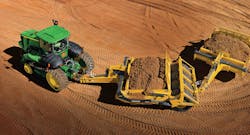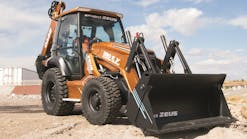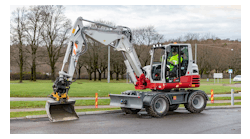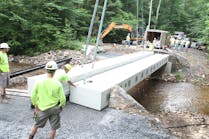Instead of attacking dirt in massive bucket-sized scoops, a scalpel-like VE tool pierces with laser focus and efficiency-applying air or water-striking the ground with impact and precision.
In the pneumatic version, air gets tightly compressed through a controlled aperture; in one such tool the pressurized air emerges at Mach 2 speed, says Andrew Hartman, who is sales and marketing manager of the tool’s maker, Supersonic Air Knife Inc., of Allison Park, PA. Poked into the ground at a steady clips, the AirKnife will pulverize it, expand it like a small seismic shockwave, kick it up skyward, and keep excavating all day long. After all, it runs on air.
The resulting hole comes out at usually 1 or 2 square feet in circumference, or whatever’s needed to expose the underground element of interest.
Loosened material-whether carved out by a water jet or air-comes out either as a muddy slurry or dry spoils, depending on which. In either case, it’s then vacuumed up.
Compared to serious trenching work, VE is but a limited “boutique” digging niche. As Hartman points out, only a couple of companies make the high-performance nozzles that Hartman sells-although venturesome excavators, he notes, have been known to fashion their own crude ones by simply pounding a tube tip to a narrow edge.
Offering a bit of history: Air “knives” were first introduced in 1986. The current patent ownership moved to Hartman’s employer about eighteen years ago. Supersonic makes a half-dozen variations now; some nozzles can handle either liquid or air.
A vacuum “sister tool” that Hartman describes, runs from a compressor rather than a vac, and sucks or blows material out through a discharge tube.
As for the VE market, Hartman observes: “We’re still really in a kind of educational phase, even after some thirty years of trying to get the average excavation crew to understand why they need a tool like this and why they should be using it for the hand-dig zone… There really are a lot of places where air should be used,” he adds, “but still isn’t.”
Most commonly applied at the very start of excavation work to verify utility markups and visually locate buried lines, pipes, cables, wires, tanks, tree roots, etc., VE will enable crews “to go in with heavy equipment with more confidence and be fairly certain that you’re not going to run into trouble,” explains Hartman.
In this role, air- or water- digging, plus vacuuming, is the alternative to shoveling by hand.
These days, though, as Ben Schmitt, product manager of Vactor Manufacturing in Streator, IL, points out, “The utility segment appears to be less than 20% of total vacuum excavation.” Instead, recent demand for VE work has soared and shifted amidst the nation’s booming oil and gas production sector.
To obtain VE services, Schmitt adds, excavation contractors typically turn to VE experts. But larger digging companies “are starting to purchase their own machines as well, when justified,” he adds.
Immersion by Water by Pneuma
Talk to devotees of air excavation these days, and you will hear them extol VE virtues with a fervor that almost sounds reverential. Since virtually all excavators began their careers with conventional trenching and hoeing, they have comparative experiences to draw upon. Their switch to specializing on VE reminds one of a conversion of faith.
First, typically, comes a taste of hydro digging (apparently, more pervasive than air, at least according to the sources interviewed here). Afterwards comes the discovery of the aerated alternative. Everyone likes the latter a lot. The reason? Above all, air provides a remarkably desirable cleanliness at pneumatic job sites. These are a triumph over messy, water-soaked, apocalyptic mud pits ensuing from hydro VE.
In a couple of cases, the affection that air VE inspires is so complete, excavators will revamp their businesses, virtually to forsake water for it’s sake-although it’s more typical to hear diggers concede, “Yeah, we still do both.” This comes out a bit grudgingly, though. Their hearts are with pneuma.
Torry Olive is operations manager for BBU Environmental and Central States Environmental, two sister companies that excavate Ohio and surrounding states. Hydro VE was launched by BBU/CSE there about eight years ago, he recounts: “We played around with it a bit. Basically, it consisted of using a regular turbo vac and a steamer unit.”
Then, clients started asking about air. “So we did a little bit of research on it, went out and got an air spade tool, and started using that with our turbo vac. Things just kind of grew from there,” he says.
BBU/CSE started renting bigger trucks for hauling “huge” pneumatic blowers that air VE requires; work managers had discovered that the minimum practical size for VE with air is probably around 6,300 cfm. BBU/CSE opted for versatile Guzzler trucks, which could handle not only the super-sized compressors but be reconfigured, as needed, to perform other tasks as well.
“Once we became proficient,” Olive continues, “we started letting people know we have this technology and can service this part of the industry.” Word-of-mouth in the Midwestern petrochemical trenching market spread. “You do a job with one pipeline inspector,” Olive recounts. “He likes the truck. He likes the technology. He likes that fact that air material remains dry and there is no muddy mess. You can dump it on site or back in the hole once you’re done digging. You don’t have any impaction issues.” Then the duly impressed inspector “moves to another area and tells everyone there about it. It just kind of spread that way.”
These days, Olive says, out in the marketplace he finds, “One of biggest misconceptions is that you cannot go through hard-packed surfaces with air. But you can. It takes you a little longer, but you can do it,” he says with confidence.
In the wake of success and growing demand, VE competitors have jumped in. “They’re more than capable of getting our business,” Olive concedes. “But one of the things in the environmental industry is loyalty. Once you get in somewhere, people like you and typically they’ll keep you as long as you don’t make a serious mistake. It’s not that we have a corner on the market, but with loyal customers, it is working out really well.”
Ideal for the Sandy Southeast, Far West
Christopher Niebuhr, president and chief operating officer of Thompson Industrial Services LLC, based in Sumter, SC, does air VE (and other) excavation work for firms like Duke Energy and for multiple regional nuclear power stations. These days, he says, “We do air more than any other kind.”
Why so?
“Because [clients] just refuse to let us use a backhoe anymore,” he says. “They don’t know what’s underground there.” As nuclear sites seek expansion, “They have 40-year-old drawings, but don’t trust them.”
They call Thompson to bring out the air knives. In contrast, for the occasional greenfield project, conventional excavation is typically preferred, Niebuhr notes.
Thompson’s project manager for nuclear digging, Jerome L. Lawson, discusses his steady work assignments for the past several years that have been heavily skewed to air VE. Thompson, he recalls, first launched pneumatic service in 2001. Since then his crews have dug hundreds of holes this way. Prior to that, says Lawson, “when digging with a mini-excavator or big track hoe, you’d ruin things. You’d scrape stuff and then tear lines away-fiber optic cables,” for example. Those days are over now. Nuclear site work firmly dictates about a 70% overall preference for compressed-air power as the tool of choice. “Surveyors come out and mark the ground for what we call “˜a soft dig,'” says Lawson, meaning either air or water but no heavy stuff. “They locate where they think the lines are. Point me in the right direction to dig, and I go to whatever depth or width they need.”
One of the most ardent advocates of air work we spoke with is John West. He’s vice president of Ultra Engineering Contractors Inc., of Winchester California and sponsors an informative air VE website, www.digwithair.com. With over 20 years in the excavation business, UEC’s service territory reaches all of California south of Sacramento, West says. The “ultra” part of the company name refers to extremely safety-conscious digging. “That’s all we do is dig safely,” he says. This accounts for why, for the past three years straight, UEC has been hauling forth its pneumatic tools more or less exclusively, 99% of the time. Hydro serves as a rare backup only. Previously, UEC had paired hand digging with hydro.
Why the radical shift to the air?
“We saw a need for it. There weren’t a lot of guys out there offering it. A lot of clients began asking for it. So we got into it,” he answers.
Ultra has enjoyed steady growth since, and has added round-the-clock emergency repair services for utility-related sites. “We’re running our trucks full time every day,” he says. “We’re booked up typically for months in advance. We’ve got two more trucks on order. We’re really happy with the way things are going. Our clients are extremely happy and the air technology, to me, seems to make the most sense.”
Why so?
“First and foremost,” West continues, “we can use the same soil that we removed from the hole to put back in. We back-fill and move on. We can do a lot more holes a lot faster, if a client is asking us to do the backfilling.”
Selling-wise, “It’s a matter of educating the market on what we’re capable of doing,” he sums up. “Once we get out there and show them, typically we’ve got a costumer for life.”
Hydro VE Not Drying-Up Yet
With such uplifting testimonials about aeration’s advantages, water-digging would seem to be going down the drain-but, of course, it’s not that simple. The hydroexcavators are extremely well-entrenched. They too have passionate defenders. Several notable advantages are repeatedly touted and seem to be keeping the industry afloat, as it were, and ensuring that commercial job orders keeps flowing.
One steadfast advocate of hydroexcavation is Jason Proctor. He’s product manager for the vacuum excavation product line at Ditch Witch, a major supplier of hydro vacuum units as well as conventional trenchers, plows, horizontal drills, back hoes, and such.
Proctor acknowledges the rapturous buzz that air has enjoyed, but nevertheless says he’s “just not seen where air excavation is as productive as hydro.” Given that Ditch Witch’s product line is currently conventional and hydro-oriented, Proctor also admits a certain bias on this point. But he strongly hints that pneumatic equipment may well be forthcoming for Ditch Witch. “Even though we don’t make air [tools] today…that’s not to say we won’t have them in the future, and we absolutely see the value of them,” he says.
All in all, water blasting is simply faster-cutting and more productive than air, Proctor believes.
Another strength of water is the fact that, against frozen ground “air excavation isn’t going to work that well. But with hydroexcavation you can use heated water” to dislodge icy sod easily. Hot water can also hasten the breakup of clay, and is useful for non-excavation job-site chores like cleanup and scouring.
Lastly, Proctor notes, there’s another downside with air VE, in that, wherever air is pounding dirt and kicking it skyward, the work area requires shielding “You’re basically blasting the ground apart. Surrounding homes, vehicles traffic and passers-by are more at risk with flying debris” than with hydroexcavation, he says.
How about code and regulatory status?
As it happens, in mid-year AirKnife’s Hartman undertook to find out how both modes of VE have been received in various codes and standards. He was hoping to learn that they’re being widely recognized and officially adopted. What he actually found, he reports, is that best-practices clauses still uphold hand-digging near utilities-or prudent equivalents. The latter generally include a reference to pneumatic digging, he adds. However, he says of the regulatory industry, “Nobody has gotten as specific as to say that an air knife or similar tool must be used. They get as far as mentioning pneumatic digging and then listing it in a glossary somewhere…” he says with a note of disappointment.
Moreover, all of the locally adopted best practices for digging ultimately seem to cite a common boilerplate statement on this subject recently formulated by the utility industry’s Common Ground Alliance. The latest version came out just this year. CGA’s discussion on vacuum excavation “still reads pretty much the same” in 2013 as when first introduced in 2010, Hartman adds. He regularly attends CGA meetings, and he praises the nonprofit organization for getting the word out that air tools are faster and safer than hand digging. However, he adds, this endorsement has taken a remarkably long time to obtain.
A second bit of recognition for soft digging dates back to 2003. At that time, a forerunner of the present CGA participated with the US Department of Transportation in a grant to the New York State Department of Public Service, aimed at defining best practices for digging around buried utility lines. In those days, “damage to underground structures” is “significant,” even when lines are properly marked. This statement appears in a subsequent NYDPS white paper titled the “Vacuum Excavation Demonstration Project” (VEDP), dated 2006 and published online at www.digsafelynewyork.com. VE researchers back then also expressed concern that “advances in vacuum technology…[and] in pneumatic and hydraulic equipment intended to safely expose underground facilities are not being fully utilized in the field.”
To remedy this, various stakeholder from New York utility-marking organizations (e.g., Dig Safely New York and the Northeast Gas Association) were assembled; the VEDP was the result.
In the study project, a total of seven local excavators participated. Results of their 106 VE digging sites were then analyzed. The study sought to compare “soft” vacuum digging benefits versus hand digging with shovels, assessing relatives costs, drawbacks, efficiency, etc.
As the eventual report later put it, “Perhaps most important question was Would the excavator use this technology if they had to pay for it themselves, rather than having it underwritten by grants?”
Results-wise, all but one of the excavators agreed that “using vacuum excavation to locate utilities made the task easier and more efficient.”
All reported that VE saved time.
All but one reported that VE saved money.
How about VE enabling workers to avoid damage?
Six of seven companies said “yes,” (again, out of a total of 106 VEs job sites; two minor inadvertent, unavoidable damage incidents occurred that likely would have happened by hand-digging as well, the report noted).
Participants also felt that VE was better suited to some sites and tasks than others. Especially apt roles for VE include: utility location verification; potholing; directional-bore projects, especially where routes cross utility or gas lines or where lines are within roads or paving; locating existing facilities for repair or rerouting; utility projects with spatial constraints; urban projects; and projects seeking to limit surface disturbance.
Of seven participating excavators, all reported they would indeed consider purchasing or renting VE equipment for themselves in the future.
All in all, the study proved VE to be a resounding success. VE demonstrated “clear and distinct advantages over hand digging to locate utilities.” VE “…saves design, excavation, and construction time and…money, minimizes damages, while complying with construction codes,” the VEDP report states.
At the time of its publication, the study was so eye-opening for New York excavators that the NYDPS decided to thump the results in a promotional booklet.
Naturally, the study steered clear of endorsing either hydro or air against each other. Nor did it tout equipment brands. But there was frank discussion of several key differences, including statements such as these:
- “… water…at high pressures can damage underground utilities, and there are documented cases of this occurring.”
- Water is also “a very good conductor of electricity” which means it presents a hazard of electrocution.
- “In cold or freezing temperatures, working with water can be difficult,” as “equipment can freeze, and there may be sloppy, difficult conditions at the discharge points. Environmentally friendly antifreeze solutions are often required,” the report says. More favorably, the report notes that hot water easily cuts frozen ground.
- Air excavation is superb for locating lines, being nonconductive and carrying the lowest hazard. “When air hits a utility line, it will flow around without damaging it,” the report states. Air also won’t damage road base or tree roots
The report took note of the perception that a water excavator’s cannon-like force cuts holes much faster than air. Thus, it conceded, water “works best in moderate temperatures for big jobs, especially if a convenient dump and water refill source” are present.
As for comparative market reception of air versus water in New York, the report stated: “Until recently [as of 2006], compressed-air vacuum excavation equipment was the most commonly used. Now, with the advent of less expensive water systems, those have become more prevalent.”
On the other hand, the report noted that air offers easier use, and this would seem to portend a boost in its market share. Air equipment is also typically “smaller, lighter and more economical” than hydro support tools, the report notes.
Air can cut all soil types, including clay or densely packed soils, but works best with sandy soil or loose loam, the report adds.
In contrast, hydro digging requires larger trucks and trailers to carry water-in fact, two tanks often are needed, one to haul the fresh water supply and another to cart away the muddy waste. When fresh water is exhausted, an excavation gets put on hold until the tank can be refilled. Contrast this with air VE in which “On-board compressors generate a limitless supply of air,” the report concludes approvingly.
When it comes to cleanup and restoration, air again seems to present a big advantage. Getting rid of hydro VE mud is comparatively difficult. It’s usually not suitable for back fill after the underground utility elements have been laid bare. So, the excavation contractor must come up with dry fill. Conversely, with pneumatic excavation the dry spoils of the dig sit handily nearby, ready for reuse in the same hole.
Market Opinion Update, 2013
A quick survey of our excavators interviewed here adds a few further insights, essentially confirming the determinations in New York. Following is a sampling of quotes and observations.
Comparing Water VE to Air…
DitchWitch’s Proctor: A lot of the customers insist that productivity with water “outweighs the ability to put dry spoils back in the ground.” This preference is confirmed by the sheer numbers of customers “who still continue to do hydro versus air excavation,” he adds.
Thompson LLC’s Lawson: “I used water on a trench about 100 feet long, 11 feet wide and 9 feet deep. It took me about a month…with two water guns.” The same job with air would have taken six months, he estimates.
UEC’s West describes how much faster air is than water, when you factor-in the comparative time needed for backfill/mud removal/restoration. “A lot of places won’t even take mud anymore,” he begins. And here’s one head-to-head comparison: Working against one of Ultra’s competitors in Southern California, “using the exact same trucks as they did and working exactly the same delineation, we outperformed them, digging eleven holes [with air] in the same time frame it took them to dig three. … Air makes so much more sense,” he concludes. “One truck can typically do 15 holes a day from start to finish. That includes backfilling and putting in the cold patch.”
On VE Messiness in Environmentally Sensitive Areas…
Lawson: “Sometimes, inside a nuclear site you especially don’t want to splash water everywhere…”
Olive, on digging near petrochemical or gas facilities: “Our [air digging] crews can work three day straight and not have a waste lagoon full of oily water that’s got to be solidified or pumped out or hauled to a landfill,” he says. “With air, at the end of day you just basically have got a big, dry pile of dirt.” Clients are ecstatic. “That seems to be the big kicker.”
On Avoiding Damage to Underground Lines…
Proctor, rebutting the negative claim in the New York VEDP that hydro work can damage utility lines: “CGI advises that water [VE] is “˜very safe,’ so long as the pressure does not exceed 3,000 psi and the nozzle producing the linear stream of pressurized water is not aimed directly at the utility lines.”
AirKnife’s Hartman: “If you’re talking about pipelines that have a protective coating on them or a fiber optic cable that is buried directly…you can still cause damage to it, even with a hand shovel or with a pick.”
Vactor’s Schmitt: “Hydroexcavation does not produce the sandblasting effect the way air does. This reduces the potential for damage to underground utilities.”
On Worker Safety…
Olive: “If we’re going down to find a utility line or a pipe, somebody has to get in the hole and work on it. Water in the hole-sometimes mixed with oil-will loosen up the wall of your excavation. I don’t like putting anyone in a hazard like that.”
West: “Out of the 15,000 holes we’ve dug, we haven’t had an electric line break once. But if we were ever to crack [one]… with air, you’re a lot safer, especially with the fact that we use a Fiberglas air lance. So we’re insulated from the tip…”
Hartman: “The person going into the trench will be digging with a shovel, a piece of steel that usually has a fairly sharp edge on it. Or somebody will go down with a 20-pound steel digging bar with a chisel point that you kind of hurl into the ground like a spear. And, to be honest, who is the one you’re going to send down into the hole? It’s usually the enthusiastic 18-year-old who just joined the crew. And you’re saying, “˜Okay, now somebody has to dig by hand. Here you go. Go down that hole and do it. Good luck.’ Using air excavation…air is coming out at only 90 psi. It is easily deflected… It’ll break up soil. It will blow it away. But anything solid and nonporous, the air just goes around it.”
Schmitt: Operator safety training is of course critical, which Vactor provides. “The biggest safety concern with VE is… the larger units operate at 28-inches Hg of vacuum, which is capable of pulling almost 800 pounds through an 8-inch diameter hole. If an operator is not careful, a significant injury or fatality can occur… Vactor provides many standard safety features to quickly and safely disable the vacuum should an emergency occur.”
Hydro VE water pressure can range up to 3,000 psi, he says. “This can severely injure the operator or damage underground utilities.”
Air VE can also produce static electricity so tools must be properly grounded, he adds.
On market trends, client preferences…
Olive: When first introducing “soft digging” to clients, hydro is more intuitive and understandable, “and hydro has been around for many years,” he notes.
In comparison, if you say “pneumatic excavation,” lay-people “don’t really grab the concept of what you’re talking about. Pneumatic is the new kid on the block. A lot of people still just haven’t been exposed to it.” Both water and air, he finds, “are still not widely accepted.”
Proctor: “The vast majority of [VE] contractors” are using hydro vacuum excavation.” Unofficially, he puts the figure at 70% or more, “just because hydroexcavation is much more effective and productive.”
Schmitt: “Some utility companies, departments of transportation or power plants can specify pneumatic excavation for a given job for a number of reasons….”
Work, Equipment, “Parting Tips”…
Olive: One challenge for men excavating at distances away from the truck, “whether for pneumatic or hydro, is coping with the boom limited to 20 to 25 feet,” which all of them have. “Once you get away from using that boom [i.e., excavating where the boom isn’t available for hose support], that is where it gets tricky. Basically, excavation is not efficient out there.” The worker winds up man-handling a 6-inch-diameter hose. This usually happens if the truck boom can’t get close enough. So, he advises, try to arrange the job site to overcome this.
West, on trucks: “We like having everything on one truck, having one equipped with every piece of equipment we can think of that would possibly be needed to get the job done.” Olive also buys trucks through a custom shop that builds to his design specs, so the $400,000 vehicle with a turbo vac can be used for work besides pneumatic excavation. GapVax and Badger are two preferred equipment suppliers for pneumatic and hydro.
Lawson on compressors: “Make sure you find out what psi to cut with,” as newcomers to vacuum excavation usually lack the necessary field experience to know which power combinations can cut what.
The water standard is 2,000 psi, he adds.
“If you want to go with air, you’ve got to make sure your application tips are right and know something about how they cut. Some people come in there and they don’t know how to use the application right. Make sure you run tests on how much material you can move over time,” in order to give the customer an accurate job quote.
Lawson on air against clay: “Clay is no problem. If you give me a 375 psi air compressor I can cut that clay just as good with air as water,” he says. An under-powered 185 psi will take much longer. And a very high-powered 750 “is definitely going to cut the [expletive] out of it. I’ve’ gone as far down as 18 feet and [trenching] 200 feet long,” in clay, with 750 psi, he reports. Compressors require adequate horsepower as well-60 to 100 horsepower, he advises.








